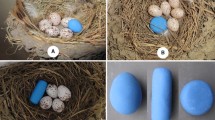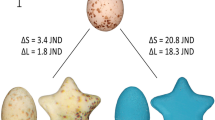Abstract
Nestling recognition and rejection is a rare defense strategy against avian brood parasitism that was previously thought to be too costly to evolve. Recently, several examples of nestling recognition and rejection by fosterers have been reported. Here, we tested for chick recognition ability in red-rumped swallows (Hirundo daurica), which build closed nests and do not discriminate against foreign eggs, by using cross-fostering experiments while controlling for responses to intraspecific and interspecific parasitism in closely related swallow species. We show that red-rumped swallows do not discriminate against conspecific or barn swallow (H. rustica) nestlings, but eject or reject cuckoo nestlings cross-fostered in red-rumped swallow nests by starving the introduced chicks to death. Assuming that the behavior of red-rumped swallows evolved in response to cuckoo parasitism, this study represents novel empirical evidence showing that chick discrimination evolved when brood parasites have completely evaded host defenses at the egg stage. The evolution of such recognition ability may be explained as a defense against avian brood parasitism by small-sized cuckoos or a pre-adaptation to specific communication between host parents and offspring. Our results are consistent with the “rarer enemy” hypothesis predicting that nestling discrimination should evolve only in hosts that accept all naturally laid parasite eggs and thus do not decrease effective parasitism rate at the nestling stage. In contrast, the findings were inconsistent with a number of alternative hypotheses.

Similar content being viewed by others
References
Anderson MG, Hauber ME (2007) A recognition-free mechanism for reliable rejection of brood parasites. Trends Ecol Evol 22:283–286
Avilés JM, Vikan JR, Fossøy F, Antonov A, Moksnes A, Røskaft E, Shykoff JA, Møller AP, Stokke BG (2012) Egg phenotype matching by cuckoos in relation to discrimination by hosts and climatic conditions. Proc R Soc Lond B 279:1967–1976
Brown CR (1984) Laying eggs in a neighbor’s nest: benefit and cost of colonial nesting in swallows. Science 224:518–519
Colombelli-Négrel D, Hauber ME, Robertson J, Sulloway FJ, Hoi H, Griggio M, Kleindorfer S (2012) Embryonic learning of vocal passwords in superb fairy-wrens reveals intruder cuckoo nestlings. Curr Biol 22:1–6
Davies NB (2000) Cuckoos, cowbirds and other cheats. T. & A. D Poyser, London
Davies NB (2011) Cuckoo adaptations: trickery and tuning. J Zool 284:1–14
Davies NB, de Brooke ML (1989) An experimental study of co-evolution between the cuckoo, Cuculus canorus, and its hosts. I. Host egg discrimination. J Anim Ecol 58:207–224
Grim T (2006) The evolution of nestling discrimination by hosts of parasitic birds: why is rejection so rare? Evol Ecol Res 8:785–802
Grim T (2007) Experimental evidence for chick discrimination without recognition in a brood parasite host. Proc R Soc Lond B 274:373–381
Grim T (2011) Ejecting chick cheats: a changing paradigm? Front Zool 8:14
Grim T, Kleven O, Mikulica O (2003) Nestling discrimination without recognition: a possible defence mechanism for hosts towards cuckoo parasitism? Proc R Soc Lond B 270:S73–S75
Langmore NE, Hunt S, Kilner RM (2003) Escalation of a coevolutionary arms race through host ejection of brood parasitic young. Nature 422:157–160
Langmore NE, Maurer G, Adcock GJ, Kilner RM (2008) Socially acquired host-specific mimicry and the evolution of host races in Horsfield’s bronze-cuckoo Chalcites basalis. Evolution 62:1689–1699
Langmore NE, Cockburn A, Russell AF, Kilner RM (2009) Flexible cuckoo chick-rejection rules in the superb fairy-wren. Behav Ecol 61:497–503
Langmore NE, Stevens M, Maurer G, Heinsohn R, Hall ML, Peters A, Kilner RM (2011) Visual mimicry of host nestlings by cuckoos. Proc R Soc Lond B 278:2455–2463
Lawes MJ, Marthews TR (2003) When will rejection of parasite nestlings by hosts of nonevicting avian brood parasites be favored? A misimprinting-equilibrium model. Behav Ecol 14:757–770
Li S, Chen M, Wang L, Liang W (2013) Parasitic brood nestlings exchange experiment in four species of Passeriformes. J Hainan Normal Univ (Nat Sci) 26:417–420
Liang W, Yang C, Wang L, Møller AP (2013) Avoiding parasitism by breeding indoors: cuckoo parasitism of hirundines and rejection of eggs. Behav Ecol Sociobiol 67:913–918
Lotem A (1993) Learning to recognize nestling is maladaptive for cuckoo Cuculus canorus hosts. Nature 362:743–744
Lyon BE, Eadie JM (2004) An obligate brood parasite trapped in the intraspecific arms race of its hosts. Nature 432:390–393
Møller AP (1987) Intraspecific nest parasitism and anti-parasite behaviour in swallows, Hirundo rustica. Anim Behav 35:247–254
Møller AP (1989) Intraspecific nest parasitism in swallows, Hirundo rustica: the importance of neighbours. Behav Ecol Sociobiol 25:33–38
Møller AP, Brohede J, Cuervo JJ, de Lope F, Primmer CR (2003) Extrapair paternity in relation to sexual ornamentation, arrival date and condition in a migratory bird. Behav Ecol 14:707–712
Payne RB (2005) The cuckoos. Oxford Univ Press, Oxford
Sato NJ, Tokue K, Noske RA, Mikami OK, Ueda K (2010) Evicting cuckoo nestlings from the nest: a new anti-parasitism behaviour. Biol Lett 6:67–69
Shizuka D, Lyon BE (2010) Coots use hatch order to learn to recognize and reject conspecific brood parasitic chicks. Nature 463:223–226
Soler M (2014) Long-term coevolution between avian brood parasites and their hosts. Biol Rev 89:688–704
Soler M, Martínez JG, Soler JJ, Møller AP (1995) Chick recognition and acceptance: a weakness in magpies exploited by the parasitic great spotted cuckoo. Behav Ecol Sociobiol 37:243–248
Soler JJ, Pérez-Contreras T, De Neve L, Macías-Sánchez E, Møller AP, Soler M (2014) Recognizing odd smells and ejection of brood parasitic eggs: an experimental test in magpies of a novel defensive trait against brood parasitism. J Evol Biol 27:1265–1270
Taborsky M (2010) Sample size in the study of behaviour. Ethology 116:185–202
Tokue K, Ueda K (2010) Mangrove gerygones Gerygone laevigaster eject little bronze-cuckoo Chalcites minutillus hatchlings from parasitized nests. Ibis 152:835–839
Yang C, Liang W, Cai Y, Shi S, Takasu F, Møller AP, Antonov A, Fossøy F, Moksnes A, Røskaft E, Stokke BG (2010) Coevolution in action: disruptive selection on egg colour in an avian brood parasite and its host. PLoS ONE 5:e10816
Yang C, Antonov A, Cai Y, Stokke BG, Moksnes A, Røskaft E, Liang W (2012a) Large hawk-cuckoo Hierococcyx sparverioides parasitism on the Chinese babax Babax lanceolatus may be an evolutionarily recent host-parasite system. Ibis 154:200–204
Yang C, Liang W, Antonov A, Cai Y, Stokke BG, Fossøy F, Moksnes A, Røskaft E (2012b) Diversity of parasitic cuckoos and their hosts in China. Chinese Birds 3:9–32
Yang C, Stokke BG, Antonov A, Cai Y, Shi S, Moksnes A, Røskaft E, Møller AP, Liang W, Grim T (2013) Host selection in parasitic birds: are open-cup nesting insectivorous passerines always suitable cuckoo hosts? J Avian Biol 44:216–220
Yang C, Møller AP, Ma Z, Li F, Liang W (2014) Intensive nest predation by crabs produces source-sink dynamics in hosts and parasites. J Ornithol 155:219–223
Yang C, Wang L, Liang W, Møller AP (2015) Nest sanitation behavior in hirundines as a pre-adaptation to egg rejection to counter brood parasitism. Anim Cogn 18:355–360
Acknowledgments
We would like to thank Prof. Manuel Soler, Theo C. M. Bakker and two anonymous reviewers for their constructive and helpful comments that greatly improved this manuscript. We are grateful to Wenfeng Wang and Jianhua Ma from Zhalong National Nature Reserve for the help and cooperation, and to Qiuli Huang, Shanshan Li and Yungao Hu for their assistance with fieldwork. This study was supported by the National Natural Science Foundation of China (Nos. 31260514 to CY, 31272328 and 31472013 to WL), and Program for New Century Excellent Talents in University (NCET-13-0761) to CY.
Ethical standard
The experiments comply with the current laws of China where they were performed.
Conflict of interest
The authors declare that they have no conflict of interest.
Author information
Authors and Affiliations
Corresponding author
Additional information
Communicated by M. Soler
Electronic supplementary material
Below is the link to the electronic supplementary material.
Video S1
Ejection of live cuckoo chick by red-rumped swallow parents. (MP4 1314 kb)
Rights and permissions
About this article
Cite this article
Yang, C., Wang, L., Chen, M. et al. Nestling recognition in red-rumped and barn swallows. Behav Ecol Sociobiol 69, 1821–1826 (2015). https://doi.org/10.1007/s00265-015-1994-x
Received:
Revised:
Accepted:
Published:
Issue Date:
DOI: https://doi.org/10.1007/s00265-015-1994-x




